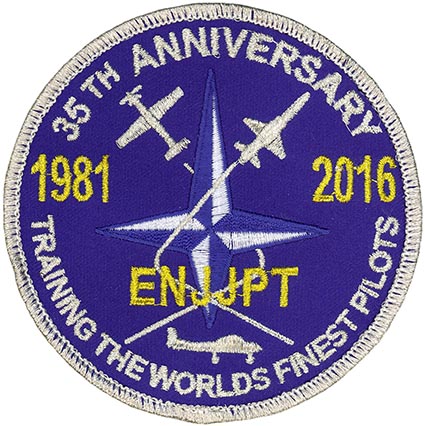Description
Computer made/mounted on velcro 4.0 inch-100mm
80th FLYING TRAINING WING (AETC)
Lineage. Established as 80 Pursuit Group (Interceptor) on 13 Jan 1942. Activated on 9 Feb 1942. Redesignated 80 Fighter Group (Single Engine) on 15 May 1942. Inactivated on 3 Nov 1945. Consolidated (31 Jan 1984) with the 80 Flying Training Wing, which was established on 23 May 1972. Activated on 1 Jan 1973.
Assignments. III Interceptor (later, III Fighter) Command, 9 Feb 1942; First Air Force, 20 Jun 1942; I Fighter Command, 4 Jul 1942; New York Air Defense Wing, 11 Aug 1942-10 May 1943; Tenth Air Force, 28 Jun 1943; American Air Command 1 (later, 5320 Air Defense Wing [Provisional]), Sep 1943; Tenth Air Force, 20 Jun 1944; Army Air Forces, India-Burma Theater, c. 1 Aug-9 Oct 1945; New York Port of Embarkation, 1-3 Nov 1945. Air Training Command, 1 Jan 1973; Nineteenth Air Force, 1 Jul 1993-.
Components. Group. 80 Operations: 2 Jan 1998-. Squadrons. 88 Pursuit (later, 88 Fighter; 88 Flying Training): 9 Feb 1942-3 Nov 1945; 1 Jan 1973-2 Jan 1998. 89 Pursuit (later, 89 Fighter; 89 Flying Training): 9 Feb 1942-3 Nov 1945; 1 Jan 1973-2 Jan 1998. 90 Pursuit (later, 90 Fighter; 90 Flying Training): 9 Feb 1942-3 Nov 1945; 1 Jan 1973-2 Jan 1998. 459 Fighter: 1 Sep 1943-13 Mar 1944.
Stations. Selfridge Field, MI, 9 Feb 1942; Bridgeport, CT, 25 Jun 1942; Farmingdale, NY, 5 Jul 1942; Mitchel Field, NY, 9 Mar-30 Apr 1943; Karachi, India, 28 Jun 1943; Kanjikoah, India, Sep 1943; Nagaghuli, India, 11 Oct 1943; Tingkawk Sakan, Burma, 29 Aug 1944; Myitkyina, Burma, 20 Jan 1945; Moran, India, 4 May 1945; Dudhkundi, India, 24 May-6 Oct 1945; Camp Kilmer, NJ, 1-3 Nov 1945. Sheppard AFB, TX, 1 Jan 1973-.
Aircraft. P-47, 1942-1943, 1944-1945; P-40, 1943-1944; P-38, 1943-1944. T-37, 1973-2009; T-38, 1973-; AT-38, 1993-; T-6, 2008-.
Operations. Trained for combat and served as part of the defense force for the northeastern United States, 1942-1943. Sailed for India, via Brazil, Cape of Good Hope, and Ceylon, in May 1943. Began combat operations in Sep 1943. Supported Allied ground forces during the battle for northern Burma and the push southward to Rangoon, bombing and strafing troop concentrations, supply dumps, lines of communication, artillery positions, and other objectives. Defended the Indian terminus of the Hump route by striking Japanese airfields and patrolling Allied airfields to safeguard them from attack. Received a DUC for intercepting a formation of enemy aircraft and preventing its attack on a large oil refinery in Assam, India, on 27 Mar 1944. Withdrawn from combat in May 1945. Since Jan 1973, provided undergraduate pilot training, initially for USAF, German Air Force, and Vietnamese Air Force students. Although Vietnamese Air Force pilot training ceased in Sep 1974, students from other nations continued to train under the security assistance program through Apr 1980. Provided USAF rotary-wing pilots’ conversion training to fixed-wing aircraft, Jun 1977-Nov 1981. Conducted undergraduate pilot training and pilot instructor training under the Euro-NATO Joint Pilot Training program, beginning Oct 1981, with participating nations contributing staff and financial support. In Jan 1994, began training Euro-NATO pilots in fighter fundamentals, using AT-38 aircraft.
Service Streamers. World War II: American Theater.
Campaign Streamers. World War II: India-Burma; Central Burma.
Armed Forces Expeditionary Streamers. None.
Decorations. Distinguished Unit Citation: India, 27 Mar 1944. Air Force Outstanding Unit Awards: 10-20 Apr 1979; 30 Apr 1981-29 Apr 1983; 1 Jul 1999-30 Jun 2001.
Emblem. Approved for the group on 14 Oct 1942 and for the wing on 2 Jan 1973.
